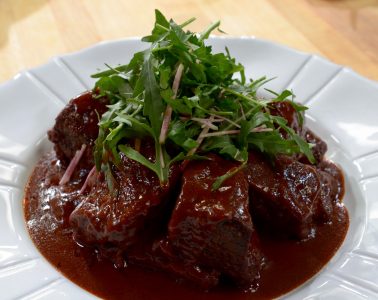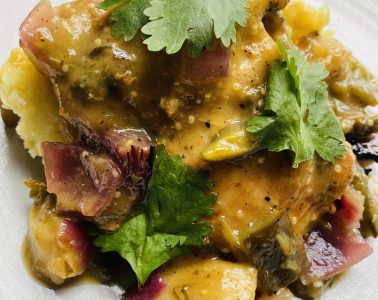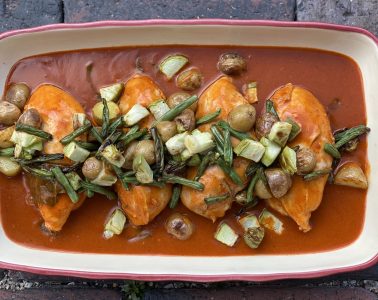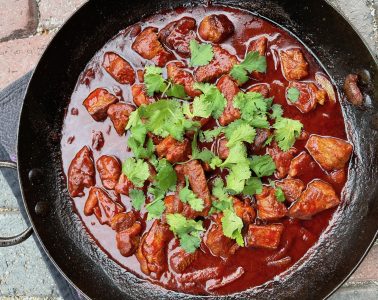INGREDIENTS
- About 4 6-ounce pieces (1 ½ pounds total) thin-cut beef steaks—less than ½-inch thick is ideal OR 2 very large or 4 medium (1 ½ pounds total) boneless, skinless chicken breasts
- 2 eggs
- Salt
- About 3/4 cup all-purpose flour
- About 2 cups bread crumbs (panko is my first choice)—you may need more to evenly cover wide pieces of beef
- Oil to a depth of ½ inch for frying
- About 1 1/2 cups Avocado-Tomatillo Salsa
- About 3/4 cup Pickled Onions & Fresh Chiles
INSTRUCTIONS
Prepare the meat or chicken. For beef: Cut the meat into 4 portions if necessary. One by one, cover each piece with a sheet of plastic (grocery or vegetable bags work well here) and use a mallet or other heavy object to pound it to about ¼ inch thick (even if it’s thin, pound it a little to break up the structure so it doesn’t curl during frying). Single pieces will be about 8x5 inches. For chicken: For very large chicken breasts, cut each in half horizontally, producing 2 thinner pieces; medium breasts don’t need to be split. One by one, lay a portion between two sheets of plastic (grocery or vegetable bags work well here) and use a mallet or other heavy object to pound it to about ¼ inch thick.
Bread the milanesas. Crack the eggs into a large pie plate (or something similar), measure in a teaspoon of salt and beat with a fork until thoroughly blended and no streaks of yolk or white remain. Spread out the flour and the bread crumbs, each on their own large pie plates (or something similar). Line them up: flour followed by eggs and bread crumbs. One by one, sprinkle both sides of the beef or chicken with salt, then dip both sides into the flour and pat to remove any excess. Next, dip both sides into the egg (I hold the pieces with a pair of tongs), letting excess drain off, then lay into the crumbs. Press crumbs firmly into both sides. Lay in a single layer on a baking sheet.
Fry the milanesas. Heat the oil in a very large (12-inch) heavy skillet over medium-high. When shimmering and hot enough to make the edge of a milanesa sizzle sharply, fry the milanesas in batches until richly brown, about 2 minutes on each side. Drain on on a wire rack or paper towels on a rimmed baking sheet, keeping them warm in a low oven until all are fried.
Serve the milanesas. Lay a portion on each dinner plate, spoon some salsa over the top and scatter on some pickled onions and chiles. It’s ready to serve.
NOTES
Buying beef for milanesa: Many grocery stores sell thin-cut beef (often cut from the round or chuck) called whatever their clientele sparks to: minute steaks, breakfast steaks, sandwich steaks, you name it. Most of what you find will work for this preparation, though they may not be sold in 6-ounce pieces. So just buy 1 ½ pounds, pound them if they’re too thick, bread the pieces you have and match them up to make 4 portions. In most Mexican groceries, you can buy beef for milanesa, often sold in very large pieces that are thin and have been tenderized. Again, just buy the full quantity and cut them into manageable pieces, matching them up, if necessary, to make your 4 portions. Even though most Mexican groceries sell already-breaded beef for milanesa, I wouldn’t suggest buying it. Your breading will be better.
Other proteins for milanesa. While beef (and now chicken) makes up the bulk of Mexico’s milanesas, I love fish done this way. Choose 4 pieces/1 ½ pounds total of skate wing or 4 medium tilapia (or similar) fillets. In my opinion, this is about the best way to serve tilapia.
Crumbs: While panko produces an exceptionally crunchy coating (and are thankfully widely available), so do corn flakes—a popular substitution for bread crumbs on Mexico’s upper west coast. I scoop them into a bowl and crush them with the back of a cup until reduced to the size of panko crumbs.
For the professional: Once the breading has set onto the protein, the uncooked milanesas can be lightly stacked, covered and refrigerated for a day or so. We deep-fry the milanesas at 360 degrees in our restaurants, drain them and serve immediately. In my opinion, anything more than a few minutes in a warming oven reduces the quality of the crunchy coating.




